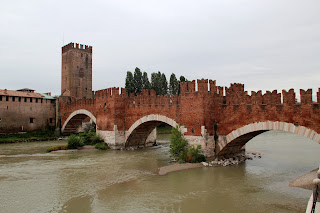Leaving
Venice mid morning we arrived little more than an hour later in Verona, the
second city on our list as a potential base and home.
With the
train station about a 10 minute walk to Piazza Bra, we decided to walk even
though the skies threatened rain showers. Unfortunately, we took the wrong exit
from the station, extending the distance and time to get to our apartment. Just
past the halfway point we were getting wet in the rain. Our travel jackets and
hair getting more soaked by the minute. Coming across a restaurant we stopped
for lunch and hope the rain would pass…not only were the staff most helpful and
understanding but the meal was absolutely delightful. By the time we finished
lunch the rain had ended and we had dried out.
Our
apartment was a minute’s walk from Piazza Bra well within the early medieval city
and on the edge of the Roman city. The city has evidence of three fortresses
and walls…the Roman walls, the early medieval city and the thick late medieval
city walls. Today the late medieval broad walls with its fortresses that were designed
to resist cannon shells have been turned into a parkway that runs from the
river on the east side to the river on the west (the old city sits inside a “U”
in the Adige River).
Like Parma,
Verona is in the lush agricultural Po Valley. Serving as the setting of
Shakespeare’s Romeo and Juliet, and The Taming of the Screw, Verona has a
population of just over 265,000 (725,000 people in the greater region). The
northern Italy city has long been a transportation hub that today is on the main
rail line between Venice and Milan, and at the end of the Brenner Pass route
into Austria. Lake Garda is less than a 20 minute drive to the northwest and
the ski resorts of the Dolomite Mountains to the north.
Our first afternoon evening was given to visiting our immediate area, the Arena and Piazza Bra, and then walking through the ancient shopping street Via Mazzini to another major square, Piazza della Erbe. Built by the Romans before the Roman Coliseum, the Arena is still used today as a major venue for concerts. With a renown summer opera season, opera is its most common entertainment. Unfortunately all but a small portion of the outer ring no longer exists due to a 12th century earthquake.
Originally
seating 30,000 the Arena seats only half that number today for concerts. As we
sat and walked around the inside of the Arena we both wondered what it would be
like to attend a musical performance in the 2,000 year old venue. Artists take such
pride in having performed there that they often mention it in their
professional summaries that are printed in concert brochures (when we went to
Carmen at the Kennedy Center, one of the major performers had the Arena as one
of four notable places where he had performed).
I was struck
that many of streets in the old city have marble walkways and streets. A number
of the smaller main streets that don’t carry large heavy vehicles are marble. With
marble quarries nearby, the builders of 1,800-2,200 years ago were making do
with what they had nearby.
The Arena
isn’t the only antiquity performance site still in use in Verona. Just across
the Adige River, almost opposite the Roman bridge Ponte di Petra, is an outdoor
theatre built into hillside, the Teatro Romano. We were unable to tour the
theatre as a stage and lighting from a recent event was being dismantled.
The Ponte di
Petra, built in the second century before Christ, is one of two ancient bridges
in use today by pedestrians and bicyclists to cross the river. Ponte di Petra,
like the 14th century Castelvecchio Bridge, was destroyed by
retreating Nazi troops in World War II. Both bridges were carefully rebuilt using
much of the recovered original material as possible.
The medieval
Castelvecchio Bridge crosses the river at the Castelvecchio, a red bricked
castle. Today the castle is a city park and museum.
As it was at
the end of our street we passed through the Porta Borsari several times. Porta
Borsari, an archway entry built in the 2nd century as an entrance
into the Roman city. It stands today astride a major shopping street. Since
Porta Borsari was the main entryway into the city, it was more elaborately
constructed and decorated than other entry ways.
We didn't venture off to see the "home" of Juliet and her balcony. Seeing the home of this fictional character was not high on our list as it is for other visitors.
Overall, we
enjoyed our stay in Verona. Thursday, over dinner at a Piazza Bra restaurant we
wished we could stay longer in Verona. We loved the city’s character and feel...and knew that we could readily live here.

















No comments:
Post a Comment